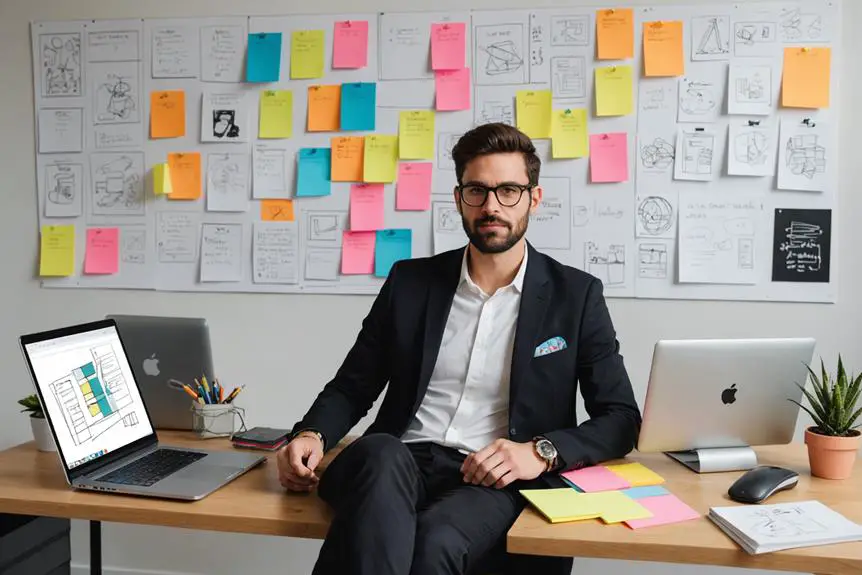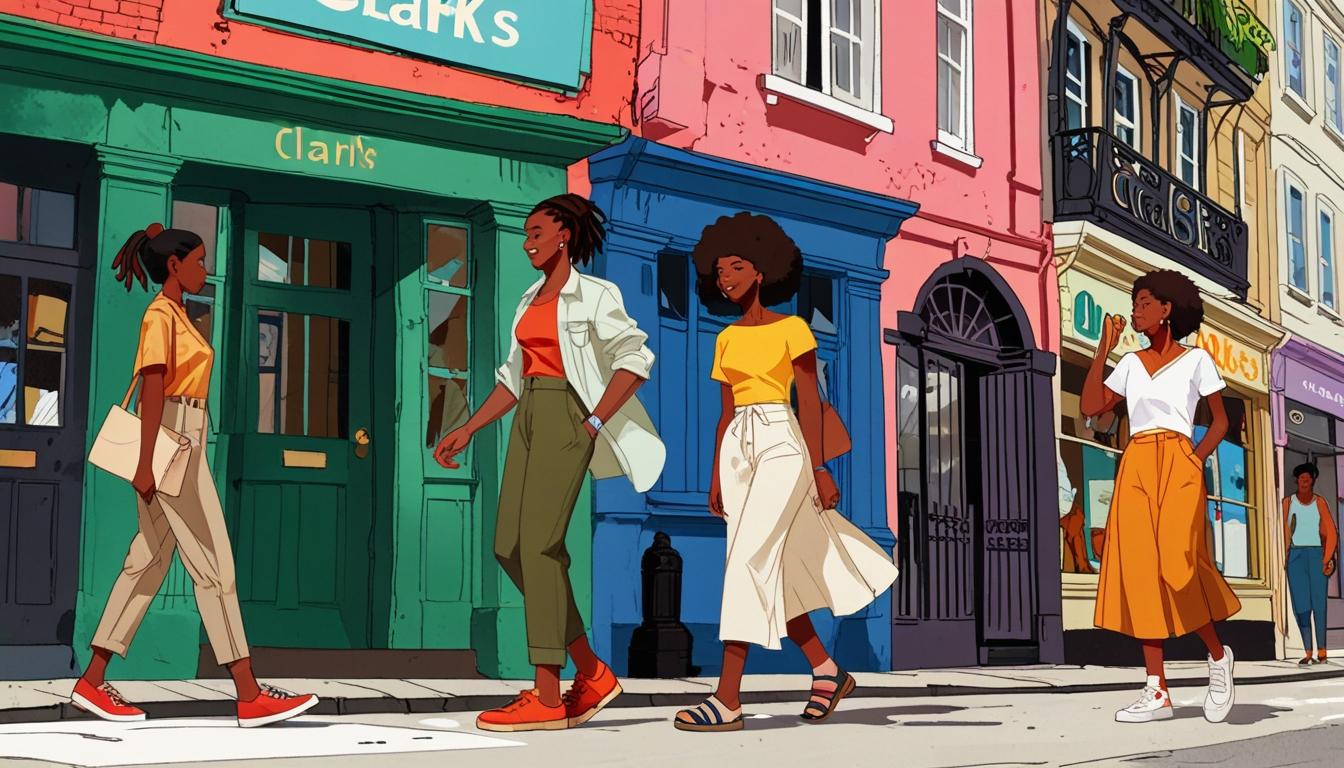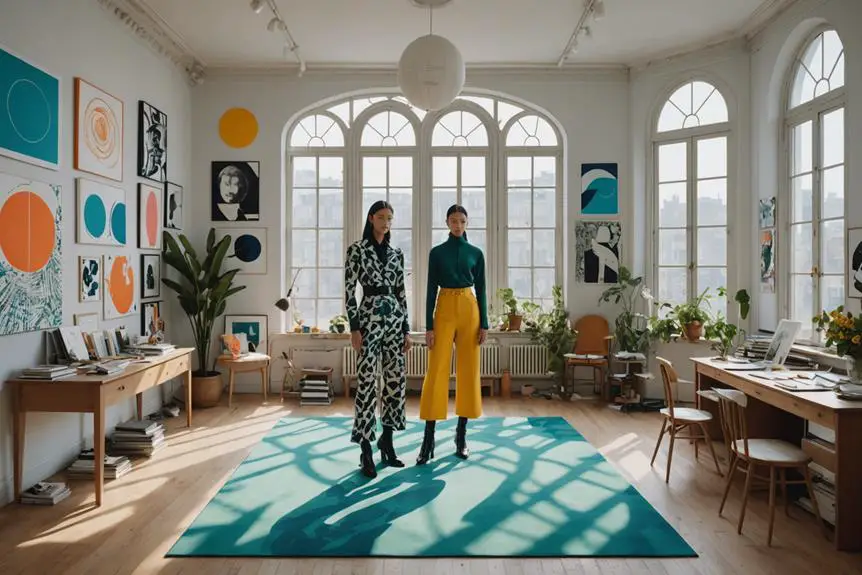To dress as a UX designer, you'll want to strike a balance between creativity and professionalism. Start by understanding the company culture—research its vibe to select outfits that align with its values. Opt for a smart casual style, like tailored shirts and fitted jeans, accompanied by comfortable shoes that let you navigate your day with ease. Prioritize comfort to boost your confidence, and don't forget to incorporate your unique flair. Plan your outfits in advance to avoid morning stress, and keep flexible options handy for unexpected changes. Exciting tips and insights await you as you further explore this topic!
Understand Company Culture
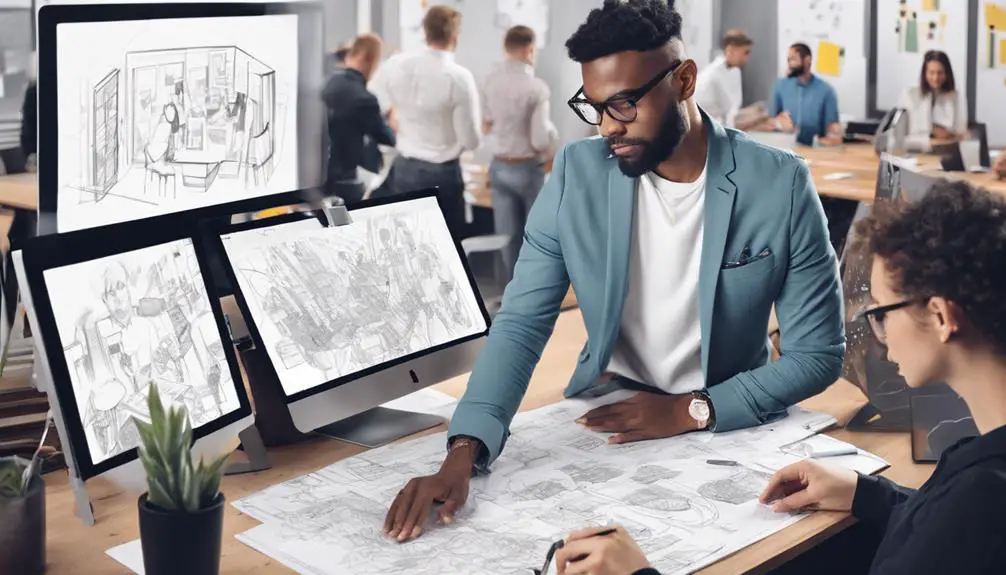
To effectively dress as a UX designer, you first need to understand the company's culture. Researching the company's website and social media can give you valuable insights into its brand identity and overall vibe. This knowledge is essential for determining what attire's appropriate. Is the environment conservative, corporate, or casual? Knowing the level of formality helps you select an outfit that aligns perfectly with the workplace atmosphere.
Analyzing the company's values and tone is key to ensuring your clothing reflects the organization's image. For instance, if you're interviewing at a financial institution, opting for conservative attire shows that you respect their formal culture. On the other hand, if you're eyeing a position at a trendy fashion brand, dressing in stylish, contemporary clothing demonstrates your ability to fit in with their creative environment.
As a UI designer or UX designer, dressing according to the company's culture not only shows respect but also enhances your chances of making a positive impression during interviews or daily work. It indicates that you understand the company's ethos and are ready to contribute to its goals. By matching your outfit style to the company's vibe, you'll communicate that you're not only a skilled designer but also someone who values the team's culture. So, take the time to research, analyze, and choose wisely—your wardrobe can truly set the tone for your success in the UX field!
Choose Role-Appropriate Attire
Choosing the right attire as a UX designer means striking a balance between professionalism and comfort. As a designer, you'll want to adopt a smart casual style that reflects your focus on user-centric design principles while allowing for personal expression. Think tailored shirts or stylish blouses paired with well-fitted jeans or chinos. This combination not only looks polished but also gives you the freedom to showcase your creativity. Additionally, consider the importance of brand representation in your attire, akin to how Abercrombie & Fitch has evolved its image over the decades through its logo evolution.
When accessorizing, remember that functionality meets style. A sleek laptop bag or a sophisticated watch can enhance your overall appearance without being overly distracting. These elements signal your professionalism while maintaining your unique designer flair. Footwear is equally important; opt for comfortable yet fashionable options like sneakers or loafers. You'll appreciate the ease of movement when maneuvering between meetings and collaborative sessions throughout your day.
Moreover, choosing clothing that aligns with your personal style while adhering to your company's culture is essential. This approach demonstrates your ability to connect with brand identity and user expectations, a significant trait for any successful designer. By selecting outfits that resonate with your aesthetic while keeping the workplace environment in mind, you'll create a powerful impression that reflects your role and expertise.
Ultimately, the goal is to feel confident in your attire as you tackle the challenges of UX design. So, embrace your individuality, dress appropriately, and let your outfit tell a story about who you are as a designer!
Prioritize Comfort and Confidence
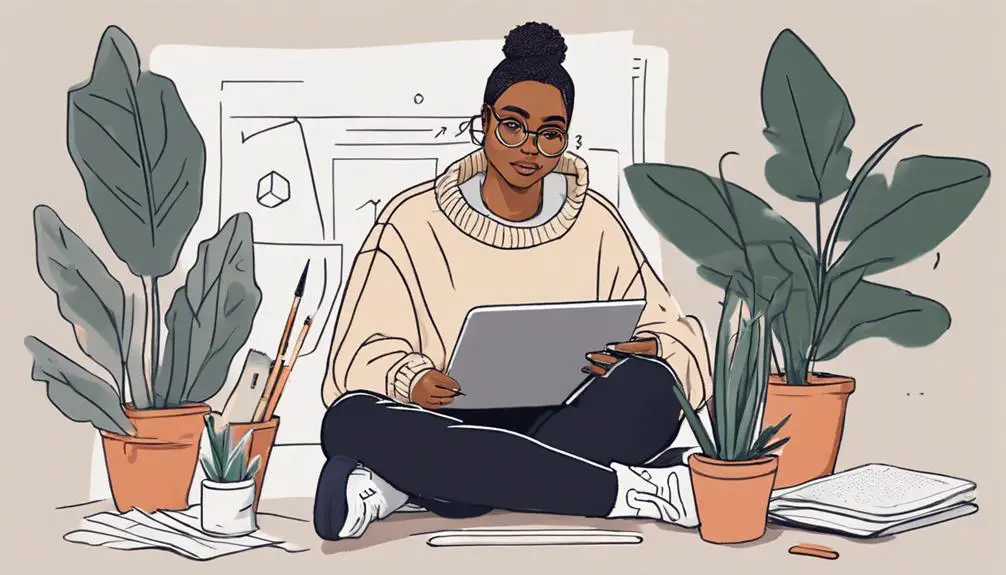
Feeling comfortable and confident in your attire can greatly impact your performance as a UX designer. When you choose clothing that fits well and flatters your body shape, you not only enhance your appearance but also boost your confidence during interviews and presentations. Comfortable attire allows you to stay focused on your design work instead of being distracted by discomfort, especially during long work sessions or meetings.
To help you prioritize comfort and confidence, here's a quick reference table:
| Factor | Importance | Tips for Implementation |
|---|---|---|
| Well-Fitting Clothes | Boosts confidence and enhances appearance | Choose styles that fit your body type |
| Personal Style | Reflects your unique identity | Incorporate your favorite colors or patterns |
| Distraction-Free | Maintains focus on work | Opt for breathable fabrics and flexible fits |
| Positive Mindset | Encourages creativity | Wear what you love and feel good in |
| Empowering Attire | Improves performance | Dress for success, aligning outfit with goals |
Plan Your Outfit in Advance
Planning your outfit in advance is a game changer for any UX designer. By checking the company's dress code and preparing for the weather, you can guarantee your look aligns with the culture while keeping you comfortable. Organizing your outfit components the night before not only streamlines your morning routine but also boosts your confidence, allowing you to focus on showcasing your creativity and skills.
Check Company Dress Code
Before you finalize your outfit for the interview, it is crucial to check the company's dress code. Understanding the dress code gives you a clear direction on how to present yourself, ensuring you align with the company's culture and values. You can easily gather this information by researching the company's website and social media. This will help you determine if the environment is formal, casual, or somewhere in between.
To help you visualize different dress codes, here's a quick reference table:
| Dress Code | Description | Outfit Examples |
|---|---|---|
| Formal | Professional attire, often for corporate roles | Suit, dress shoes, blazer |
| Business Casual | Smart but relaxed, suitable for most offices | Slacks, button-up shirts, loafers |
| Casual | Relaxed and comfortable, often in startups | Jeans, t-shirts, sneakers |
| Creative Casual | Encourages personal style and creativity | Stylish tops, unique accessories |
Planning your outfit in advance can save you from last-minute stress. By preparing your clothes, accessories, and shoes the day before, you can focus on showcasing your skills confidently during the interview.
Prepare for Weather Conditions
Checking the weather forecast is a smart move when you're selecting your outfit for the interview. By preparing for weather conditions, you verify you dress appropriately for temperature, precipitation, and wind. This attention to detail can greatly affect your comfort and confidence during the interview.
Consider layering your clothing to adapt to changing weather throughout the day, allowing for a versatile look that remains professional regardless of the climate. In warmer weather, opt for breathable fabrics, while in cooler temperatures, choose warmer materials to stay comfortable and focused. If rain's in the forecast, don your water-resistant outerwear and suitable shoes to arrive looking polished and prepared.
Planning your outfit the night before can save you time and stress. Factor in any weather-related accessories, like umbrellas or scarves, to avoid last-minute scrambles that could lead to discomfort or a less professional appearance. By taking these steps to organize your wardrobe with the weather in mind, you'll set yourself up for success, making a great impression before you even step through the door. Remember, preparation is key to feeling confident and ready to showcase your skills.
Organize Outfit Components Efficiently
Organizing your outfit components the night before can streamline your morning routine and boost your confidence for the interview. As a UX designer, you want to present yourself as polished and professional, so laying out your clothing in advance is essential. Start by choosing a designated area where you can assemble everything you'll need, including shirts, pants, accessories, and shoes. This way, you'll have all the necessary items readily available, reducing stress and decision fatigue.
Before you finalize your outfit, check the weather forecast and company dress code to avoid any unexpected issues. Utilizing wardrobe management apps can help you visualize and organize potential outfit combinations efficiently, ensuring you're showcasing your style while adhering to professional standards.
It's also wise to prepare a backup outfit option, just in case you encounter any unforeseen circumstances, such as spills or schedule changes. By planning ahead, you'll be able to focus more on your interview and less on what you're wearing. Remember, a well-organized outfit not only enhances your appearance but also sets a positive tone for your day as a UX designer!
Be Ready for Adjustments

When you step into the world of UX design, embracing flexibility in your attire is essential, as unexpected events can pop up at any moment. You'll want to keep a backup outfit or handy accessories to tackle wardrobe malfunctions, and packing essentials like stain remover or sewing kits can save the day. Remember, being ready to adjust your look based on the company's vibe or the weather not only helps you stay comfortable, but also shows you're adaptable, which is a key trait in the design field.
Embrace Flexibility in Attire
Dressing for an interview as a UX designer requires a strategic approach, and flexibility in your attire can be a game-changer. You never know when the format or location might change, so it's crucial to be prepared. Here are three tips to help you embrace flexibility:
- Backup Outfit: Always have an alternative outfit ready. This guarantees you're confident and presentable, no matter what happens.
- Extra Accessories: Carry additional accessories like ties or scarves. These can help you easily adjust your look for different levels of formality that might arise during the interview, especially in the domain of UI design.
- Weather Awareness: Check the forecast before your interview day. Being mindful of the weather lets you layer appropriately or choose lighter fabrics for comfort and style.
Prepare for Unexpected Events
While you can't predict every scenario that may arise during an interview, being prepared for unexpected events can make a significant difference in how you present yourself. Start by having a backup outfit ready—this guarantees you're covered in case of sudden weather changes or wardrobe malfunctions. Keeping essential items like a lint roller, stain remover, and an extra pair of shoes handy can help you tackle last-minute issues before or during the interview.
You should also prepare for various interview formats by having both formal and smart casual options available. This flexibility allows you to adapt your design to fit the company's culture and expectations on the fly. When considering accessories, think about carrying a simple, versatile bag to hold your essentials and maintain a polished appearance, even if your outfit needs to shift unexpectedly.
Above all, maintain a positive attitude and flexibility in your approach to dressing. Staying calm and adaptable not only enhances your confidence but also creates a positive impression, regardless of any clothing hiccups. Embrace the unexpected, and you'll navigate your interview with style and grace!
Explore Helpful Styling Apps
Numerous styling apps can considerably simplify how you curate your wardrobe as a UX designer. These tools not only aid in visualizing your outfit choices but also make managing your wardrobe fun and efficient. Additionally, exploring tailoring techniques for tops can enhance your wardrobe by ensuring a perfect fit for your professional attire. Here are three standout apps to evaluate:
- Klothed: This app allows you to try on outfits virtually, linking you with designers and creative professionals. It's perfect for visualizing your wardrobe options before stepping out the door, ensuring you always look your best.
- Whering: With over 4 million users, this social wardrobe and styling app offers features like outfit scheduling and mood-based recommendations. It helps you manage your attire effortlessly, allowing you to plan your outfits in advance and save time on busy mornings.
- PICTOFiT: Developed by Reactive Reality, this leading virtual try-on platform enhances your online shopping experience. You can see how clothes fit and look on you before making a purchase, reducing the hassle of returns and ensuring you find pieces that truly suit your style.
These styling apps emphasize user experience, offering features that streamline wardrobe management, which is essential for busy UX professionals. By leveraging these tools, you can minimize decision fatigue and focus on what really matters: showcasing your unique style with confidence and flair. Immerse yourself in these apps, and watch your wardrobe transform into a curated collection that reflects your professional identity!
Frequently Asked Questions
How Do I Brand Myself as an UX Designer?
To brand yourself as a UX designer, focus on personal branding. Define your unique design philosophy, showcase your best work in a visually appealing portfolio, and engage with the UX community through social media and local meetups.
What Makes You Stand Out as a UX Designer?
To stand out as a UX designer, you've got to showcase your unique approach. Emphasize your creativity, user-centered solutions, and storytelling skills while actively engaging with communities to elevate your visibility and impact in the field.
How Do I Present Myself as an UX Designer?
Imagine stepping into a room where all eyes are on you. You've got to present yourself confidently; professional attire speaks volumes. Choose outfits that reflect your style while ensuring you're comfortable and ready to impress.
Are UX Designers Mostly Female?
Yes, UX designers are fairly balanced in gender, with women making up about 50% of the workforce. This gender balance enriches the field, leading to diverse perspectives and more inclusive design solutions you can appreciate.
